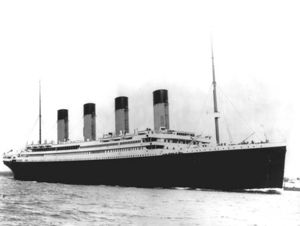CZ:Featured article/Current: Difference between revisions
imported>Chunbum Park m (→Overview) |
imported>Chunbum Park No edit summary |
||
| Line 1: | Line 1: | ||
== '''[[ | == '''[[RMS Titanic]]''' == | ||
---- | ----{{Image|Titanic.jpg|right|300px|''RMS Titanic''.}} | ||
{{Image| | '''''RMS<ref>Royal Mail Ship; the ''Titanic'' carried mail as well as passengers and other cargo.</ref> Titanic''''' was a [[passenger ship|passenger liner]] that sank on its maiden voyage in April 1912 after it struck an [[iceberg]] in the North [[Atlantic Ocean]]. Although never officially named as "unsinkable", it was believed at the time that the ''Titanic'''s design would reduce the likelihood of such a disaster. | ||
''' | |||
''Titanic'', along with its very similar sister ships ''[[RMS Olympic|Olympic]]'' and ''[[HMHS Britannic|Britannic]]'', was a [[United Kingdom|British]] vessel built in [[Belfast]] at the [[Harland and Wolff]] [[shipyard]] for the [[White Star Line]]. It left [[Southhampton]], [[England]], on 10th April 1912, bound for [[New York City|New York]] via [[France]] and [[Ireland (state)|Ireland]]. After striking an iceberg late on 14th April, the ship sank in the early hours of the following day with the loss of 1,514 passengers and crew. ''Titanic'' had too few lifeboats for the more than 2,200 people on board, and many boats left with empty spaces due to a general failure to recognise the danger until it was too late. | |||
''[[ | The iceberg opened a gash in ''Titanic'''s starboard (right) side, flooding compartments along the hull. The bow started to sink first; pressure further down the length of the ship led it to split towards the stern section. The remains of the ship lie in two main pieces two-and-a-half miles (four kilometres) below the surface. | ||
The loss of the ''Titanic'' is the world's best known maritime disaster, and forced a rethink of ship design and other safety measures. The wreck was rediscovered in the 1980s and since then various artefacts have, sometimes controversially, been raised. | |||
''[[RMS Titanic|.... (read more)]]'' | |||
{| class="wikitable collapsible collapsed" style="width: 90%; float: center; margin: 0.5em 1em 0.8em 0px;" | {| class="wikitable collapsible collapsed" style="width: 90%; float: center; margin: 0.5em 1em 0.8em 0px;" | ||
|- | |- | ||
! style="text-align: center;" | [[ | ! style="text-align: center;" | [[RMS Titanic#Footnotes|notes]] | ||
|- | |- | ||
| | | | ||
{{reflist|2}} | {{reflist|2}} | ||
|} | |} | ||
Revision as of 22:10, 12 April 2012
RMS Titanic
RMS[1] Titanic was a passenger liner that sank on its maiden voyage in April 1912 after it struck an iceberg in the North Atlantic Ocean. Although never officially named as "unsinkable", it was believed at the time that the Titanic's design would reduce the likelihood of such a disaster.
Titanic, along with its very similar sister ships Olympic and Britannic, was a British vessel built in Belfast at the Harland and Wolff shipyard for the White Star Line. It left Southhampton, England, on 10th April 1912, bound for New York via France and Ireland. After striking an iceberg late on 14th April, the ship sank in the early hours of the following day with the loss of 1,514 passengers and crew. Titanic had too few lifeboats for the more than 2,200 people on board, and many boats left with empty spaces due to a general failure to recognise the danger until it was too late.
The iceberg opened a gash in Titanic's starboard (right) side, flooding compartments along the hull. The bow started to sink first; pressure further down the length of the ship led it to split towards the stern section. The remains of the ship lie in two main pieces two-and-a-half miles (four kilometres) below the surface.
The loss of the Titanic is the world's best known maritime disaster, and forced a rethink of ship design and other safety measures. The wreck was rediscovered in the 1980s and since then various artefacts have, sometimes controversially, been raised.
| notes |
|---|
|
